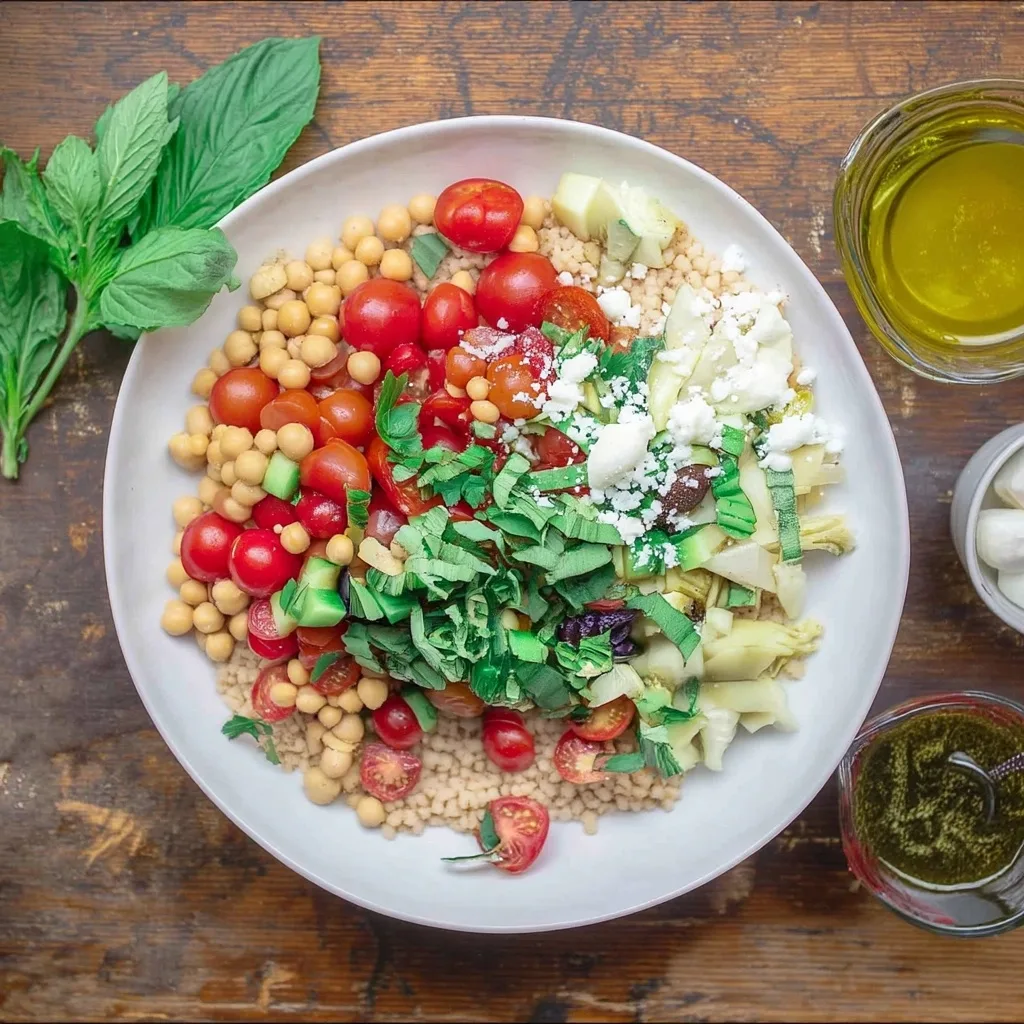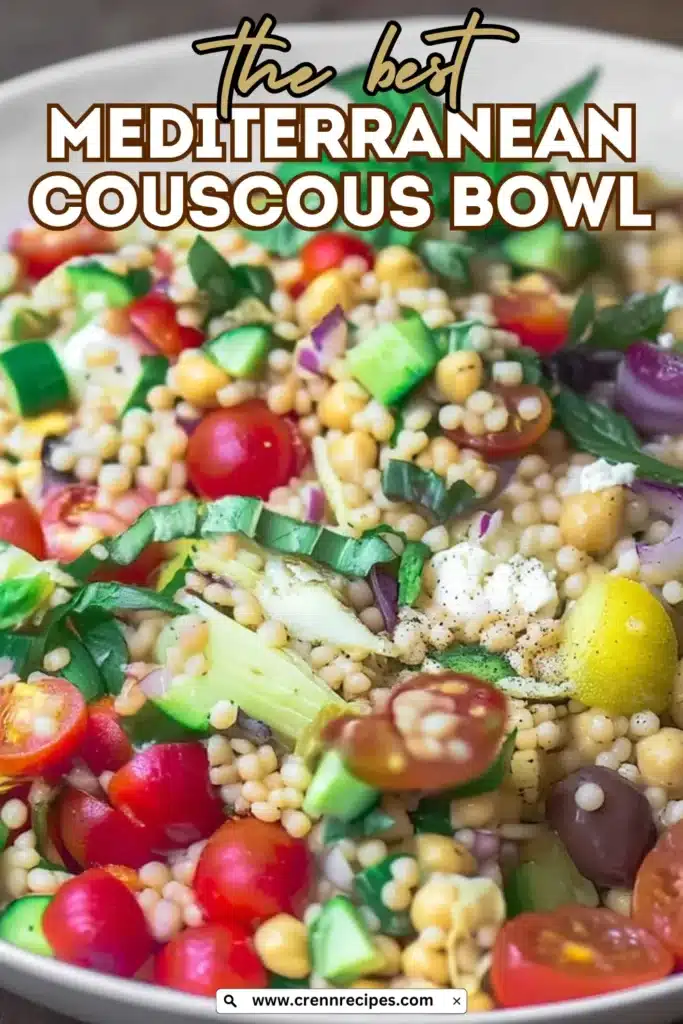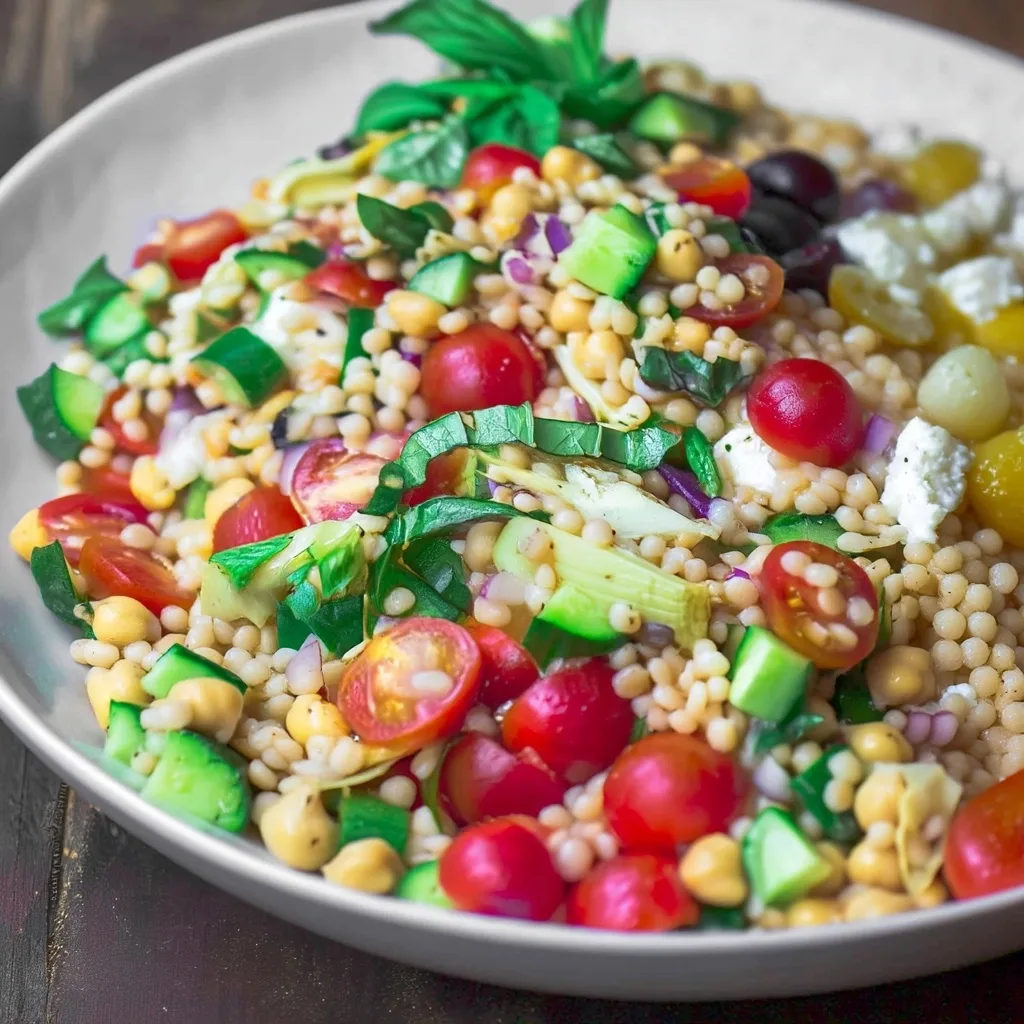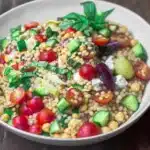When you’re craving something fresh, satisfying, and bursting with Mediterranean flavors, nothing beats a well-crafted Mediterranean couscous bowl. This isn’t just another grain bowl—it’s a vibrant celebration of the sun-soaked flavors that make Mediterranean cuisine so irresistible. Packed with fluffy couscous, crisp vegetables, tangy feta, and protein-rich chickpeas, this Mediterranean couscous bowl delivers everything your taste buds are craving in one gorgeous, Instagram-worthy dish.
What makes this Mediterranean couscous bowl truly special is how it brings together the best of Mediterranean cooking in a format that’s both nourishing and incredibly satisfying. Unlike heavy, complicated meals that leave you feeling sluggish, this bowl energizes you while delivering serious flavor payoff. Plus, it’s versatile enough to work as a light lunch, substantial dinner, or even a make-ahead meal prep option that’ll have you looking forward to lunchtime all week long.
What Makes Mediterranean Couscous Bowl Special?
The magic of a Mediterranean couscous bowl lies in its perfect balance of textures and flavors. Every single bite delivers something different—the fluffy, grain-like texture of couscous, the burst of juicy cherry tomatoes, the creamy richness of feta cheese, and the satisfying bite of chickpeas. It’s like having a Mediterranean vacation on your plate, minus the expensive plane ticket.
Moreover, this Mediterranean couscous bowl represents everything wonderful about Mediterranean eating patterns. The combination of whole grains, legumes, fresh vegetables, and healthy fats creates a nutritionally complete meal that supports both your health goals and your taste preferences. The olive oil provides heart-healthy monounsaturated fats, while the chickpeas deliver plant-based protein and fiber that keeps you satisfied for hours.
The beauty of this dish also lies in its incredible adaptability. Whether you’re following a vegetarian lifestyle, trying to eat more plant-based meals, or simply looking for something fresh and flavorful, this Mediterranean couscous bowl delivers on all fronts. It’s substantial enough to serve as a complete meal yet light enough that you won’t feel weighed down afterward.
Why Choose Mediterranean Couscous Bowl Over Other Grain Bowls?
While quinoa bowls and rice bowls certainly have their place, there’s something uniquely satisfying about a well-made Mediterranean couscous bowl. Couscous has this amazing ability to absorb flavors while maintaining its distinct texture, making it the perfect base for Mediterranean ingredients.
Furthermore, couscous cooks incredibly quickly compared to other grains. While brown rice takes 45 minutes and quinoa needs at least 15 minutes, couscous is ready in just 5 minutes. This makes your Mediterranean couscous bowl perfect for busy weeknights when you want something healthy and delicious without spending hours in the kitchen.
The Mediterranean flavor profile also sets this bowl apart from other grain-based meals. The combination of lemon, oregano, olives, and feta creates a taste experience that’s both familiar and exotic, comforting yet exciting. It’s like taking a culinary trip to a Greek island without leaving your dining room.

Essential Ingredients for Perfect Mediterranean Couscous Bowl
The Foundation: Couscous
The star of your Mediterranean couscous bowl is, obviously, the couscous itself. This tiny pasta made from semolina wheat has been a staple in North African and Mediterranean cooking for centuries. The quick-cooking variety is perfect for this recipe because it becomes fluffy and light in just minutes.
When selecting couscous for your Mediterranean couscous bowl, look for the regular or medium-grain variety rather than Israeli (pearl) couscous. The smaller grains absorb the chicken broth beautifully and create that perfect, fluffy texture that makes each bite so satisfying.
The Protein Power: Chickpeas
Chickpeas are absolutely essential to a proper Mediterranean couscous bowl. These protein-packed legumes add substance and staying power to your meal while contributing that distinctive Mediterranean flavor. They’re also loaded with fiber, folate, and plant-based protein that makes this bowl a nutritionally complete meal.
Using canned chickpeas makes your Mediterranean couscous bowl incredibly convenient, but if you prefer cooking from dried beans, go for it! Just remember to plan ahead since dried chickpeas need soaking and longer cooking times.
The Flavor Makers
Cherry Tomatoes: These little bursts of sunshine are crucial to your Mediterranean couscous bowl. When sautéed briefly, they become jammy and concentrated, releasing their natural sweetness and adding incredible depth to the dish.
Kalamata Olives: No Mediterranean couscous bowl is complete without the briny, complex flavor of kalamata olives. They add that distinctive Mediterranean taste that transforms this from just another grain bowl into something truly special.
Feta Cheese: Creamy, tangy, and slightly salty, feta cheese provides the perfect counterpoint to the other flavors in your Mediterranean couscous bowl. It also adds richness and helps tie all the other ingredients together.
Nutritional Benefits and Health Advantages
Couscous: More Than Just Carbs
While couscous is primarily a carbohydrate source, it’s also a good source of selenium, a powerful antioxidant that supports immune function and thyroid health. It also provides manganese, which is important for bone health and metabolism.
In your Mediterranean couscous bowl, the couscous serves as sustained energy that won’t cause blood sugar spikes like refined grains might. When combined with the protein from chickpeas and healthy fats from olive oil, it creates a balanced meal that keeps you satisfied for hours.
Chickpeas: Nutritional Powerhouses
The chickpeas in your Mediterranean couscous bowl are nutritional superstars. They’re packed with plant-based protein, fiber, folate, iron, and magnesium. The fiber content is particularly impressive—just one cup provides about 12 grams of fiber, which supports digestive health and helps stabilize blood sugar levels.
Moreover, chickpeas contain resistant starch, a type of carbohydrate that acts like fiber in your digestive system. This means they help feed beneficial gut bacteria while keeping you feeling full and satisfied after eating your Mediterranean couscous bowl.
Mediterranean Diet Benefits
This Mediterranean couscous bowl embodies the principles of the Mediterranean diet, which has been extensively studied and linked to numerous health benefits. The combination of olive oil, vegetables, legumes, and herbs provides anti-inflammatory compounds that may help reduce the risk of heart disease and support overall longevity.
The high antioxidant content from ingredients like tomatoes, oregano, and olive oil helps protect your cells from oxidative stress. Meanwhile, the healthy fats from olive oil and the fiber from vegetables and chickpeas support heart health and help maintain healthy cholesterol levels.
Complete Mediterranean Couscous Bowl Recipe
Ingredient List with Measurements
- 1 cup couscous (the quick-cookin’ kind)
- 1 cup low-sodium chicken broth (or veggie broth if you swing that way)
- 1 tablespoon olive oil
- 1 clove garlic, minced
- 1 cup cherry tomatoes, halved
- 1 small cucumber, diced
- ½ cup kalamata olives, sliced
- ¼ cup red onion, finely chopped
- ½ cup crumbled feta cheese
- 1 can (15 oz) chickpeas, drained and rinsed
- Juice of 1 lemon
- 1 teaspoon dried oregano
- Salt and black pepper, to taste
- Fresh parsley, chopped (for that final pop)
Step-by-Step Preparation
Get that couscous goin’
Creating the perfect base for your Mediterranean couscous bowl starts with properly preparing the couscous. In a small saucepan, bring your chicken broth to a rolling boil. The broth is crucial here because it infuses the couscous with flavor right from the start, making every grain taste better than if you used plain water.
Once your broth is bubbling enthusiastically, stir in the couscous along with a splash of olive oil. The olive oil helps prevent the grains from sticking together and adds richness to your Mediterranean couscous bowl. Immediately cover the pan and remove it from heat—this is important because couscous cooks from steam, not direct heat.
Let the covered couscous sit undisturbed for exactly 5 minutes. During this time, the grains absorb all that flavorful broth and become perfectly tender. After 5 minutes, remove the lid and fluff the couscous with a fork, breaking up any clumps. Fluffy couscous is indeed happy couscous, and it’s the foundation of an excellent Mediterranean couscous bowl.
Sauté the garlic & tomatoes
While your couscous is resting, it’s time to develop some serious flavor for your Mediterranean couscous bowl. Heat a skillet over medium heat and add a little olive oil. Once the oil shimmers, add your minced garlic and let it sizzle for about 30 seconds until it becomes fragrant.
The key here is to wake up that garlic flavor without burning it—burned garlic will make your Mediterranean couscous bowl bitter. Once the garlic smells amazing, add those halved cherry tomatoes to the pan. Cook them for 3-4 minutes, just until they start to blister and soften slightly.
This brief cooking process concentrates the tomatoes’ natural sweetness and creates little pockets of jammy goodness that will elevate your Mediterranean couscous bowl from good to absolutely incredible. The tomatoes should still hold their shape but feel slightly softened when you press them gently.
Build your bowl like a boss
Now comes the fun part—assembling your Mediterranean couscous bowl! Grab a large serving bowl and start building your masterpiece. Begin with the fluffy couscous as your base, then add the protein-packed chickpeas. These two ingredients form the substantial foundation of your Mediterranean couscous bowl.
Next, add the diced cucumber for that crucial fresh crunch, followed by the sliced kalamata olives for their briny, complex flavor. Scatter the finely chopped red onion throughout—it adds a sharp bite that balances beautifully with the other Mediterranean flavors.
Add those gorgeous sautéed tomatoes along with any pan juices (liquid gold!), then squeeze fresh lemon juice over everything. The lemon juice brightens all the flavors and ties together your Mediterranean couscous bowl beautifully. Sprinkle the dried oregano evenly and season with salt and pepper to taste.
Give everything a thorough but gentle toss—you want to distribute all those flavors evenly throughout your Mediterranean couscous bowl without mashing the delicate ingredients.
Top it off
The final touches make your Mediterranean couscous bowl absolutely irresistible. Sprinkle that crumbled feta cheese over the top—don’t mix it in completely because you want distinct pockets of creamy, tangy cheese in every bite.
Finish with a generous sprinkle of fresh chopped parsley for color and freshness, then drizzle with a touch more olive oil if you’re feeling fancy. The extra olive oil adds richness and helps all the flavors meld together beautifully.

Advanced Cooking Techniques for Mediterranean Couscous Bowl Mastery
Couscous Preparation Perfection
The difference between okay couscous and absolutely perfect couscous lies in the details. For your Mediterranean couscous bowl, using broth instead of water is non-negotiable—it adds layers of flavor that water simply can’t provide.
Temperature control is also crucial. Your broth should be at a full, rolling boil before you add the couscous. This ensures that the grains cook evenly and absorb the liquid properly. Once you add the couscous and oil, work quickly to cover the pan and remove it from heat.
The 5-minute resting time is sacred—don’t peek under the lid! Opening it releases the steam that’s cooking your couscous, and you’ll end up with unevenly cooked grains. Trust the process, and you’ll have perfect couscous for your Mediterranean couscous bowl every time.
Tomato Technique
The way you handle the cherry tomatoes can make or break your Mediterranean couscous bowl. When halving them, cut them through their equator rather than from stem to bottom—this helps them hold their shape better during cooking.
Don’t overcrowd your pan when sautéing the tomatoes. If they’re too close together, they’ll steam rather than sear, and you’ll miss out on that concentrated flavor that makes this Mediterranean couscous bowl so special.
Creative Variations to Customize Your Mediterranean Couscous Bowl
Protein Additions
While this Mediterranean couscous bowl is satisfying as-is thanks to the chickpeas, you can easily add other proteins to suit your preferences. Grilled chicken breast, cut into strips, transforms this into a heartier meal that’s perfect for dinner.
Grilled shrimp is another fantastic addition that maintains the Mediterranean theme while adding lean protein. For a vegetarian boost, try adding some grilled halloumi cheese—it has a wonderful squeaky texture and salty flavor that complements the other ingredients beautifully.
Hard-boiled eggs also work wonderfully in a Mediterranean couscous bowl, providing additional protein while adding richness to each bite.
Vegetable Variations
The beauty of a Mediterranean couscous bowl lies in its adaptability to seasonal vegetables. In summer, try adding diced bell peppers or zucchini. Roasted red peppers add sweetness and vibrant color that makes your bowl even more visually appealing.
For autumn variations, consider adding roasted butternut squash or sweet potato cubes. These additions bring natural sweetness that pairs beautifully with the tangy feta and briny olives in your Mediterranean couscous bowl.
Artichoke hearts, either marinated or fresh, add another layer of Mediterranean authenticity and provide interesting texture contrast.
Herb and Spice Modifications
While oregano is classic, don’t be afraid to experiment with other Mediterranean herbs in your couscous bowl. Fresh mint adds brightness and coolness, while fresh dill provides an unexpected but delightful flavor twist.
A pinch of sumac adds tartness and a beautiful deep red color that makes your Mediterranean couscous bowl even more visually striking. Za’atar, a Middle Eastern spice blend, brings complexity and earthiness that elevates the entire dish.
Make-Ahead and Meal Prep Solutions
Storage Best Practices
Your Mediterranean couscous bowl is fantastic for meal prep, but proper storage is key to maintaining its fresh flavors and textures. Store the dressed couscous mixture in airtight containers in the refrigerator for up to 4 days.
However, keep the feta cheese and fresh herbs separate until serving time. The feta can make the other ingredients soggy if stored together too long, and fresh herbs lose their vibrant color and flavor when mixed in advance.
For best results, pack your Mediterranean couscous bowl components in separate compartments of a meal prep container, then combine them just before eating.
Serving Temperature Options
While this Mediterranean couscous bowl is delicious at room temperature, it’s equally enjoyable cold straight from the refrigerator. The flavors actually develop and meld beautifully when chilled, making it perfect for packed lunches or picnics.
If you prefer it warm, simply microwave individual portions for 30-60 seconds, then add fresh feta and herbs. The couscous will warm through without becoming mushy, and you’ll have a comforting, warm Mediterranean couscous bowl ready in minutes.

Perfect Accompaniments and Serving Suggestions
Complementary Sides
Your Mediterranean couscous bowl is substantial enough to serve as a complete meal, but certain accompaniments can enhance the experience. Warm pita bread or naan provides a vehicle for scooping up every last delicious bite.
A simple Greek salad on the side adds extra vegetables and complements the Mediterranean theme perfectly. The combination of crisp lettuce, more tomatoes, and additional feta creates a cohesive Mediterranean meal experience.
For a lighter option, serve your Mediterranean couscous bowl alongside some hummus and fresh vegetables for dipping.
Beverage Pairings
This Mediterranean couscous bowl pairs beautifully with refreshing beverages that complement its bright flavors. Sparkling water with lemon or lime provides a clean palate cleanser between bites.
Iced tea with mint echoes the Mediterranean herb theme while providing refreshing contrast to the rich feta cheese. For something more substantial, try a smoothie made with Mediterranean fruits like figs or pomegranate.
Troubleshooting Common Mediterranean Couscous Bowl Issues
Texture Problems
If your couscous turns out mushy in your Mediterranean couscous bowl, you likely used too much liquid or cooked it too long. Couscous should be fluffy and separate, not sticky or gummy. Next time, stick to the 1:1 ratio of couscous to liquid and don’t exceed the 5-minute steaming time.
Conversely, if your couscous seems dry or hard, you may not have used enough liquid or perhaps didn’t let it steam long enough. Make sure your broth is at a full boil before adding the couscous, and resist the urge to peek during the steaming process.
Flavor Balance Issues
If your Mediterranean couscous bowl tastes bland, it usually means you need more acid or salt. Add more lemon juice to brighten the flavors, or try a splash of red wine vinegar for additional tang.
Don’t forget that the feta cheese and olives contribute significant saltiness to your Mediterranean couscous bowl, so taste before adding extra salt. Sometimes all you need is a bit more fresh herb or a drizzle of good olive oil to bring everything together.
Frequently Asked Questions About Mediterranean Couscous Bowl
Preparation and Storage Questions
Can I make Mediterranean couscous bowl ahead of time? Absolutely! This Mediterranean couscous bowl actually improves in flavor when made a few hours ahead. The ingredients have time to meld together, creating an even more delicious result. Just keep the feta and fresh herbs separate until serving.
How long does Mediterranean couscous bowl keep in the refrigerator? Your Mediterranean couscous bowl will stay fresh for up to 4 days when properly stored in airtight containers. For best quality, add fresh feta and herbs just before serving rather than storing them mixed in.
Can I freeze Mediterranean couscous bowl? While you technically can freeze this dish, the texture of the vegetables and feta won’t be quite the same after thawing. The couscous and chickpeas freeze reasonably well, but the fresh vegetables become watery and the feta crumbles differently.
What’s the best way to reheat Mediterranean couscous bowl? You can enjoy this dish cold, at room temperature, or gently warmed. If reheating, use the microwave for 30-60 seconds, then add fresh feta and herbs. Avoid overheating, which can make the couscous mushy.
Ingredient Substitution Questions
Can I use Israeli couscous instead of regular couscous? While Israeli (pearl) couscous will work, it requires different cooking methods and times. Regular couscous creates the authentic texture that makes this Mediterranean couscous bowl so appealing, so it’s worth seeking out if possible.
What can I substitute for feta cheese? Goat cheese provides similar tanginess with a creamier texture. For dairy-free options, try a plant-based feta alternative or simply add more olives and a splash of red wine vinegar for extra tang in your Mediterranean couscous bowl.
Can I make this Mediterranean couscous bowl gluten-free? Since couscous is made from wheat, it contains gluten. For a gluten-free version, substitute quinoa or rice for the couscous. Cook according to package directions and proceed with the rest of the recipe as written.
Are there good substitutes for chickpeas? White beans like cannellini or great northern beans work wonderfully. Lentils also provide protein and fiber, though they’ll change the texture slightly. For non-legume options, try roasted chicken or grilled shrimp.
More Related Recipes You Might Enjoy
If you love this Mediterranean couscous bowl, you’ll definitely want to explore these other Mediterranean-inspired dishes that showcase similar flavors and ingredients:
- Chicken Mediterranean Wrap – All the flavors of your favorite Mediterranean couscous bowl wrapped up in a convenient, portable format
- Mediterranean Quinoa Wrap – Another grain-based Mediterranean dish that’s perfect for lunch or light dinner
- Mediterranean Pita Pocket – A handheld version of Mediterranean goodness that’s perfect for busy days
This Mediterranean couscous bowl truly represents the best of Mediterranean cuisine—fresh, flavorful, healthy, and satisfying. Whether you’re looking for a quick weeknight dinner, a meal prep option, or something impressive enough for entertaining, this dish delivers on all fronts. The combination of fluffy couscous, protein-rich chickpeas, fresh vegetables, and tangy feta creates a meal that’s both nourishing and absolutely delicious. Once you master this basic Mediterranean couscous bowl recipe, you’ll find yourself coming back to it again and again, probably with your own creative variations that make it uniquely yours.
Print
Mediterranean couscous bowl Recipe Guide for Flavor Harmony
- Total Time: 15 minutes
- Yield: 4 servings 1x
Description
A bright, make-ahead Mediterranean couscous bowl loaded with fluffy quick-cooking couscous, protein-packed chickpeas, jammy cherry tomatoes, crisp cucumber, briny kalamata olives, and tangy feta—all tossed in a lemon-oregano vinaigrette. Perfect for meal prep, light lunches, or a vibrant dinner that comes together in under 15 minutes.
Ingredients
1 cup low-sodium chicken or vegetable broth
1 tbsp olive oil
1 clove garlic, minced
1 can (15 oz) chickpeas, drained and rinsed
1 cup cherry tomatoes, halved
1 small cucumber, diced
½ cup kalamata olives, pitted and sliced
¼ cup red onion, finely chopped
½ cup crumbled feta cheese
Juice of 1 lemon
1 tsp dried oregano
Salt & freshly ground black pepper, to taste
2 tbsp fresh parsley or basil, chopped
1 cup quick‐cooking couscous
Instructions
Cook couscous. Bring broth to a boil, stir in couscous and 1 tbsp olive oil, cover, remove from heat, and let steam for 5 minutes. Fluff with a fork.
Sauté garlic & tomatoes. In a skillet over medium, heat a drizzle of olive oil, cook garlic 30 sec until fragrant, add tomatoes, and cook 2–3 min until they just soften. Set aside.
Assemble bowl. In a large bowl, combine couscous, chickpeas, cucumber, olives, red onion, and sautéed tomatoes.
Dress & toss. Drizzle lemon juice, sprinkle oregano, season with salt and pepper, and toss gently to combine.
Finish & serve. Top with feta and fresh herbs. Serve immediately or chill for meal prep.
Notes
Make-ahead: Store components separately and assemble just before eating to preserve texture.
Variations: Add grilled chicken, shrimp, or halloumi for extra protein; swap in fresh mint or dill for oregano; sprinkle sumac or za’atar for extra zing.
Storage: Keeps up to 4 days in the fridge (feta and herbs added at serving).
- Prep Time: 10 minutes
- Cook Time: 5 minutes
- Category: Salad
- Method: No-cook (5 min steam)
- Cuisine: Mediterranean
Nutrition
- Serving Size: 1 bowl (≈350 g)
- Calories: 350 kcal
- Sugar: 5 g
- Sodium: 420 mg
- Fat: 12 g
- Saturated Fat: 4 g
- Unsaturated Fat: 8 g
- Trans Fat: 0 g
- Carbohydrates: 50 g
- Fiber: 7 g
- Protein: 10 g
- Cholesterol: 5 mg

